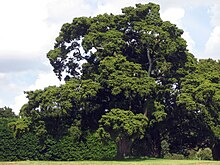| Podocarpus Temporal range:
Paleocene to recent | |
|---|---|

| |
| Podocarpus totara | |
| Scientific classification | |
| Kingdom: | Plantae |
| Clade: | Tracheophytes |
| Clade: | Gymnospermae |
| Division: | Pinophyta |
| Class: | Pinopsida |
| Order: | Araucariales |
| Family: | Podocarpaceae |
| Genus: | Podocarpus L'Hér ex Pers.[1] |
| Type species | |
| Podocarpus elongatus L'Hér ex Pers.[1]
| |
| Species | |
|
About 97–107 species, see list | |
| Synonyms | |
| |
Podocarpus (/ˌpoʊdəˈkɑːrpəs/[2]) is a genus of conifers, the most numerous and widely distributed of the podocarp family, the Podocarpaceae. The name comes from Greek πούς (poús, "foot") + καρπός (karpós, "fruit"). Podocarpus species are evergreen shrubs or trees, usually from 1 to 25 m (3 to 82 ft) tall, known to reach 40 m (130 ft) at times. The cones have two to five fused cone scales, which form a fleshy, berry-like, brightly coloured receptacle at maturity. The fleshy cones attract birds, which then eat the cones and disperse the seeds in their droppings. About 97 to 107 species are placed in the genus depending on the circumscription of the species.[1][3][4][5]
Species are cultivated as ornamental plants for parks and large gardens. The cultivar 'County Park Fire' has won the Royal Horticultural Society's Award of Garden Merit.[6]
- ^ a b c Cite error: The named reference
Farjonwas invoked but never defined (see the help page). - ^ Sunset Western Garden Book, 1995:606–607
- ^ Earle, Chris J.: Podocarpus. The Gymnosperm Database. 2013.
- ^ Ornelas, J. F.; et al. (2010). "Phylogeography of Podocarpus matudae (Podocarpaceae): pre-Quaternary relicts in northern Mesoamerican cloud forests" (PDF). Journal of Biogeography. 37 (12): 2384–96. Bibcode:2010JBiog..37.2384O. doi:10.1111/j.1365-2699.2010.02372.x. S2CID 83064504.[permanent dead link]
- ^ Barker, N. P., et al. (2004). A yellowwood by any other name: molecular systematics and the taxonomy of Podocarpus and the Podocarpaceae in southern Africa. Archived 2008-03-13 at the Wayback Machine South African Journal of Science 100(11 & 12), 629–32.
- ^ "Podocarpus 'County Park Fire'". RHS. Retrieved 18 January 2021.